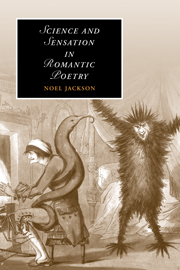Book contents
- Frontmatter
- Contents
- List of illustrations
- Acknowledgments
- List of abbreviations
- Introduction: Lyrical forms and empirical realities: reading Romanticism's “language of the sense”
- PART I SENSES OF HISTORY: BETWEEN THE MIND AND THE WORLD
- PART II SENSES OF COMMUNITY: LYRIC SUBJECTIVITY AND “THE CULTURE OF THE FEELINGS”
- PART III THE PERSISTENCE OF THE AESTHETIC: AFTERLIVES OF ROMANTICISM
- 5 John Keats and the sense of the future
- 6 More than a feeling? Walter Pater, Wilkie Collins, and the legacies of Wordsworthian aesthetics
- Notes
- Select bibliography
- Index
- CAMBRIDGE STUDIES IN ROMANTICISM
5 - John Keats and the sense of the future
Published online by Cambridge University Press: 22 September 2009
- Frontmatter
- Contents
- List of illustrations
- Acknowledgments
- List of abbreviations
- Introduction: Lyrical forms and empirical realities: reading Romanticism's “language of the sense”
- PART I SENSES OF HISTORY: BETWEEN THE MIND AND THE WORLD
- PART II SENSES OF COMMUNITY: LYRIC SUBJECTIVITY AND “THE CULTURE OF THE FEELINGS”
- PART III THE PERSISTENCE OF THE AESTHETIC: AFTERLIVES OF ROMANTICISM
- 5 John Keats and the sense of the future
- 6 More than a feeling? Walter Pater, Wilkie Collins, and the legacies of Wordsworthian aesthetics
- Notes
- Select bibliography
- Index
- CAMBRIDGE STUDIES IN ROMANTICISM
Summary
“Alas!”
Said he, “will all this gush of feeling pass
Away in solitude? And must they wane,
Like melodies upon a sandy plain,
Without an echo? Then shall I be left
So sad, so melancholy, so bereft!
Yet still I feel immortal!”
John Keats, Endymion (JK, 2:680–6)I will assay to reach to as high a summit in Poetry as the nerve bestowed upon me will suffer.
Keats to Richard Woodhouse, 27 October 1818 (JKL, 1:387)“No one can question the eminency, in Keats's poetry, of the quality of sensuousness.” John Keats's reputation as the most sensuous of British Romantic poets – next to Spenser, perhaps, England's most richly sensuous poet – has proved resilient in the years since Matthew Arnold made this pronouncement more than a century ago. My aim in the present chapter is to re-open the familiar case of Keats's “sensuousness.” In doing so, however, I wish to show how insistently Keats's writing complicates this characterization of his work. For while regularly identified with a sensuous poetic style, Keats often describes his poetry as being most closely associated not with the senses but rather with the faculty of abstraction. In a surprising number of instances, Keats's appeals to sensation remain just that: appeals self-consciously issued from the perspective of a deferred or denied sensuous immediacy.
- Type
- Chapter
- Information
- Science and Sensation in Romantic Poetry , pp. 165 - 196Publisher: Cambridge University PressPrint publication year: 2008

